Impact of Environmental Stresses on the Antibacterial Activity of Graphene Oxide (GO) Nanoparticles against P. putida Biofilms
Abstract
1. Introduction
2. Materials and Methods
2.1. Preparation of Graphene Oxide and Buffers
2.2. Bacterial Strain, Culture Conditions and Biofilm Cultivation
2.3. Environmental Stress and Quantification of Biofilm Incubated with GO
2.4. Confocal Microscopy
2.5. Statistical Analysis
3. Results
3.1. Effect of Temperature and GO on the Viability of Planktonic and Biofilm Cells
3.2. The Stability of GO in pH and NaCl Solutions
3.3. Effect of pH and GO on the Cell Viability of Biofilms
3.4. Effect of Osmotic Stress
4. Discussion
4.1. Temperature
4.2. pH Stresses
4.3. Osmotic Stress
5. Conclusions
Supplementary Materials
Author Contributions
Funding
Informed Consent Statement
Data Availability Statement
Acknowledgments
Conflicts of Interest
References
- Du, J.; Hu, X.; Zhou, Q. Graphene oxide regulates the bacterial community and exhibits property changes in soil. RSC Adv. 2015, 5, 27009–27017. [Google Scholar] [CrossRef]
- Reva, O.N.; Weinel, C.; Weinel, M.; Böhm, K.; Stjepandic, D.; Hoheisel, J.D.; Tümmler, B. Functional genomics of stress response in Pseudomonas putida KT2440. J. Bacteriol. 2006, 188, 4079–4092. [Google Scholar] [CrossRef] [PubMed]
- Beales, N. Adaptation of microorganisms to cold temperatures, Weak Acid Preservatives, Low pH, and osmotic Stress: A Review. Compr. Rev. Food Sci. Food Saf. 2004, 3, 1–20. [Google Scholar] [CrossRef] [PubMed]
- Ricker, E.B.; Nuxoll, E. Synergistic effects of heat and antibiotics on Pseudomonas aeruginosa biofilms. Biofouling 2017, 33, 855–866. [Google Scholar] [CrossRef]
- Thuptimdang, P.; Limpiyakorn, T.; McEvoy, J.; Prüß, B.M.; Khan, E. Effect of silver nanoparticles on Pseudomonas putida biofilms at different stages of maturity. J. Hazard. Mater. 2015, 290, 127–133. [Google Scholar] [CrossRef]
- Lin, H.; Chen, G.; Long, D.; Chen, X. Responses of unsaturated Pseudomonas putida CZ1 biofilms to environmental stresses in relation to the EPS composition and surface morphology. World J. Microbiol. Biotechnol. 2014, 30, 3081–3090. [Google Scholar] [CrossRef]
- Molina-Höppner, A.; Doster, W.; Vogel, R.F.; Gänzle, M.G. Protective effect of sucrose and sodium chloride for lactococcus lactis during sublethal and lethal high-pressure treatments. Appl. Environ. Microbiol. 2004, 70, 2013–2020. [Google Scholar] [CrossRef]
- Abdallah, M.; Benoliel, C.; Ferreira-Theret, P.; Drider, D.; Dhulster, P.; Chihib, N.E. Effect of culture conditions on the resistance of Pseudomonas aeruginosa biofilms to disinfecting agents. Biofouling 2015, 31, 49–59. [Google Scholar] [CrossRef]
- Akiyama, H.; Yamasaki, O.; Kanzaki, H.; Tada, J. Effects of sucrose and silver on Staphylococcus aureus biofilm. J. Antimicrob. Chemother. 1998, 42, 629–634. [Google Scholar] [CrossRef]
- van der Waal, S.V.; van der Sluis, L.W.M.; Özok, A.R.; Exterkate, R.A.M.; van Marle, J.; Wesselink, P.R.; de Soet, J.J. The effects of hyperosmosis or high pH on a dual-species biofilm of Enterococcus faecalis and Pseudomonas aeruginosa: An in vitro study. Int. Endod. J. 2011, 44, 1110–1117. [Google Scholar] [CrossRef]
- Fallatah, H.; Elhaneid, M.; Ali-Boucetta, H.; Overton, T.W.; El Kadri, H.; Gkatzionis, K. Antibacterial effect of graphene oxide (GO) nano-particles against Pseudomonas putida biofilm of variable age. Environ. Sci. Pollut. Res. 2019, 26, 25057–25070. [Google Scholar] [CrossRef] [PubMed]
- Ali-Boucetta, H.; Bitounis, D.; Raveendran-Nair, R.; Servant, A.; Van den Bossche, J.; Kostarelos, K. Purified graphene oxide dispersions lack in vitro cytotoxicity and in vivo pathogenicity. Adv. Healthc. Mater. 2013, 2, 433–441. [Google Scholar] [CrossRef] [PubMed]
- Antoniou, K.; Frank, J.F. Removal of Pseudomonas putida biofilm and associated extracellular polymeric substances from stainless steel by alkali cleaning. J. Food Prot. 2005, 68, 277–281. [Google Scholar] [CrossRef] [PubMed]
- Munna, M.S.; Zeba, Z.; Noor, R. Influence of temperature on the growth of Pseudomonas putida. Stamford J. Microbiol. 2015, 5, 9–12. [Google Scholar] [CrossRef]
- Morimatsu, K.; Eguchi, K.; Hamanaka, D.; Tanaka, F.; Uchino, T. Effects of temperature and nutrient conditions on biofilm formation of Pseudomonas putida. Food Sci. Technol. Res. 2012, 18, 879–883. [Google Scholar] [CrossRef]
- Karpouzas, D.G.; Walker, A. Factors influencing the ability of Pseudomonas putida strains epI and II to degrade the organophosphate ethoprophos. J. Appl. Microbiol. 2000, 89, 40–48. [Google Scholar] [CrossRef]
- Srivastava, S.; Yadav, A.; Seem, K.; Mishra, S.; Chaudhary, V.; Nautiyal, C.S. Effect of high temperature on Pseudomonas putida NBRI0987 biofilm formation and expression of stress sigma factor RpoS. Curr. Microbiol. 2008, 56, 453–457. [Google Scholar] [CrossRef]
- Shih, C.J.; Lin, S.; Sharma, R.; Strano, M.S.; Blankschtein, D. Understanding the pH-dependent behavior of graphene oxide aqueous solutions: A comparative experimental and molecular dynamics simulation study. Langmuir 2015, 28, 235–241. [Google Scholar] [CrossRef]
- Lee, Y.; Seo, H.; Yeom, J.; Park, W. Molecular characterization of the extracellular matrix in a Pseudomonas putida dsbA mutant: Implications for acidic stress defense and plant growth promotion. Res. Microbiol. 2011, 162, 302–310. [Google Scholar] [CrossRef]
- Mendonca, A.F.; Amoroso, T.L.; Knabel, S.J. Destruction of gram-negative food-borne pathogens by high pH involves disruption of the cytoplasmic membrane. Appl. Environ. Microbiol. 1994, 60, 4009–4014. [Google Scholar] [CrossRef]
- Pearson, J.; Southam, G.G.; Holley, R.A. Survival and transport of bacteria in egg washwater. Appl. Environ. Microbiol. 1987, 53, 2060–2065. [Google Scholar] [CrossRef] [PubMed]
- Li, D.; Müller, M.B.; Gilje, S.; Kaner, R.B.; Wallace, G.G. Processable aqueous dispersions of graphene nanosheets. Nat. Nanotechnol. 2008, 3, 101–105. [Google Scholar] [CrossRef]
- Wang, M.; Niu, Y.; Zhou, J.; Wen, H.; Zhang, Z.; Luo, D.; Gao, D.; Yang, J.; Liang, D.; Li, Y. The dispersion and aggregation of graphene oxide in aqueous media. Nanoscale 2016, 8, 14587–14592. [Google Scholar] [CrossRef]
- Niyogi, S.; Boukhalfa, S.; Chikkannanavar, S.B.; McDonald, T.J.; Heben, M.J.; Doorn, S.K. Selective aggregation of single-walled carbon nanotubes via salt addition. J. Am. Chem. Soc. 2007, 129, 1898–1899. [Google Scholar] [CrossRef] [PubMed]
- Jiao, H.; Chen, J.; Li, W.; Wang, F.; Zhou, H.; Li, Y.; Yu, C. Nucleic acid-regulated perylene probe-induced gold nanoparticle aggregation: A new strategy for colorimetric sensing of alkaline phosphatase activity and inhibitor screening. ACS App. Mater. Interfaces 2014, 6, 1979–1985. [Google Scholar] [CrossRef] [PubMed]
- Xu, S.X.; Zhang, L.L.; Zhang, H.C.; Zeng, Y.; Shi, Z.M.; Ni, S.J. A salt-assisted graphene oxide aggregation method for the determination of dimethylamine and trimethylamine by ion chromatography with conductivity detection. Anal. Methods 2016, 8, 1828–1835. [Google Scholar] [CrossRef]
- Csonka, L.N. Physiological and genetic responses of bacteria to osmotic stress. Microbiol. Rev. 1989, 53, 121–147. [Google Scholar] [CrossRef]
- Lee, W.S. Improved procedure for identification of group D enterococci with two new media. Appl. Microbiol. 1972, 24, 1–3. [Google Scholar] [CrossRef]
- Facklam, R.R. Comparison of several laboratory media for presumptive i dentification of Enterococci and Group D Streptococci. Appl. Environ. Microbiol. 1973, 26, 138–145. [Google Scholar] [CrossRef]
- Csonka, L.N.; Hanson, D. Prokaryotic Osmoregulation: Genetics and physiology. Annu. Rev. Microbiol. 1991, 45, 569–606. [Google Scholar] [CrossRef]

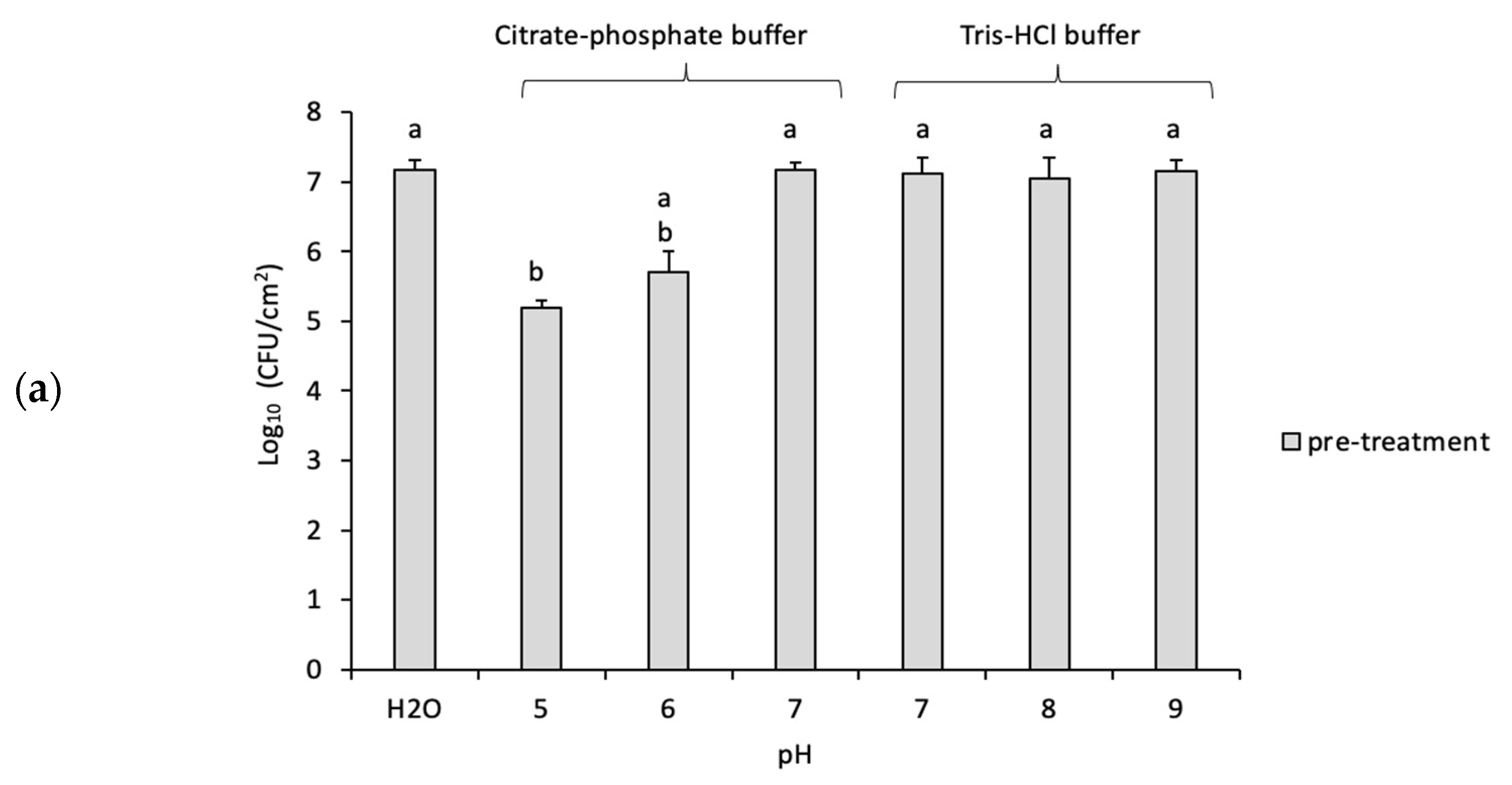
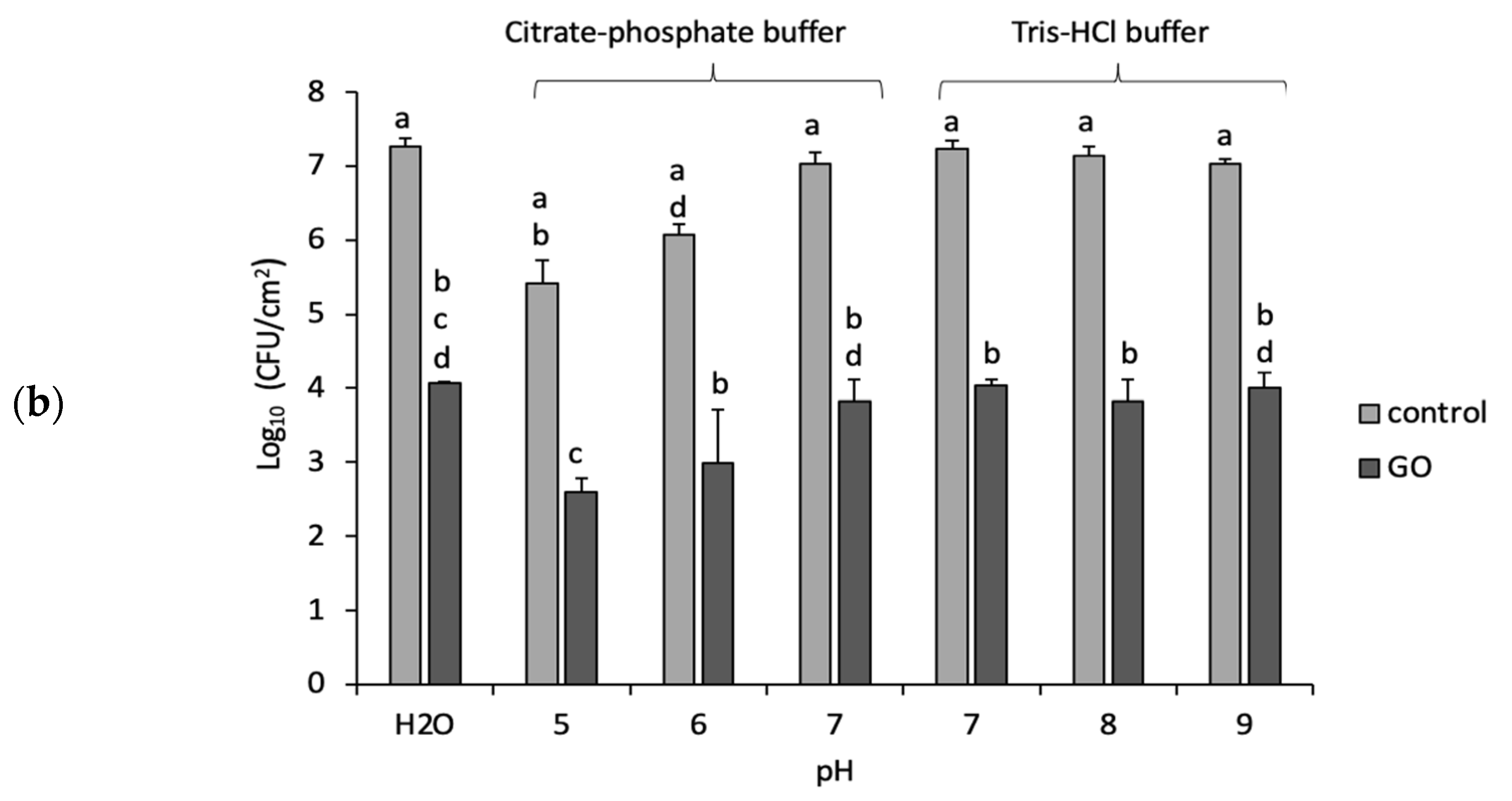
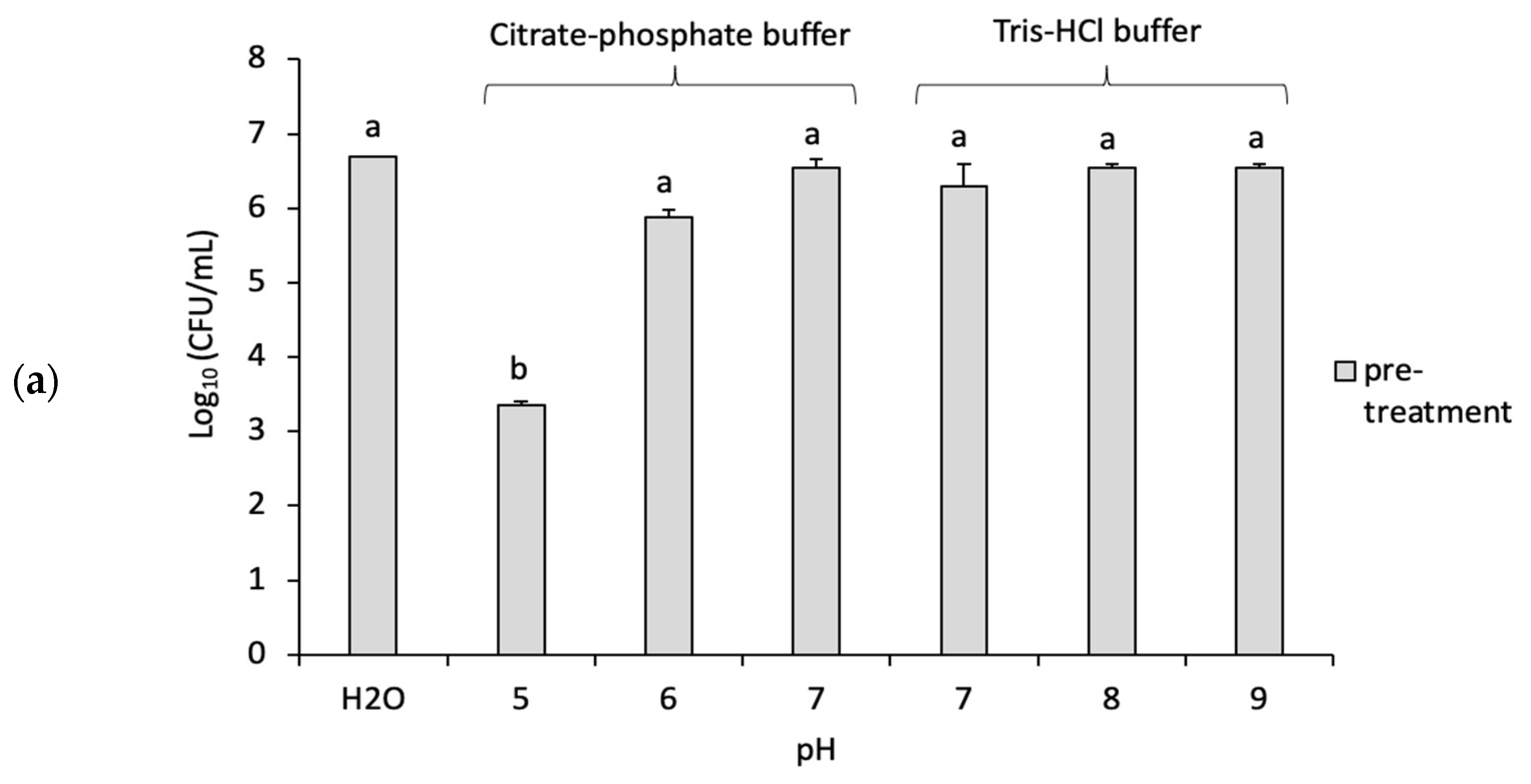
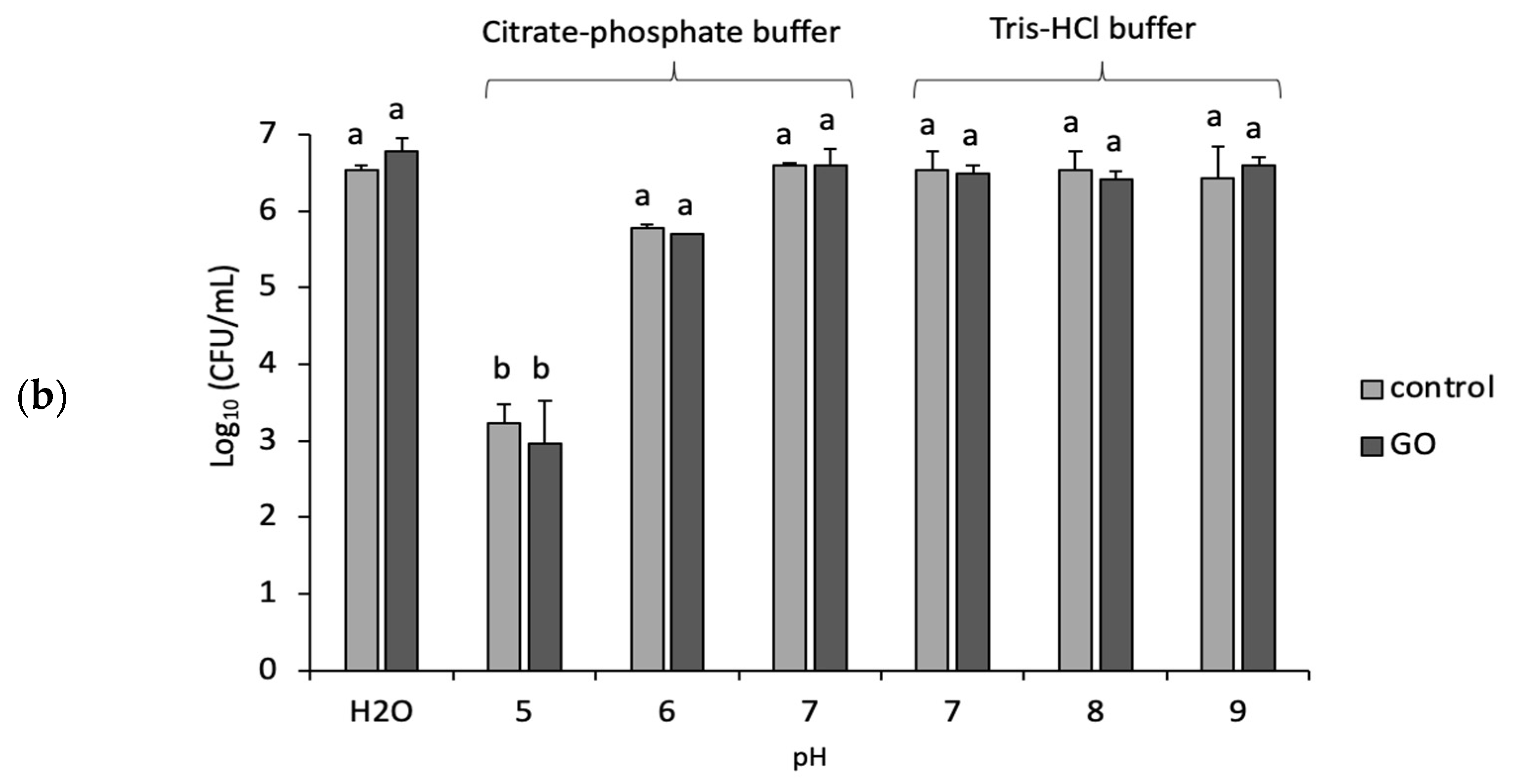


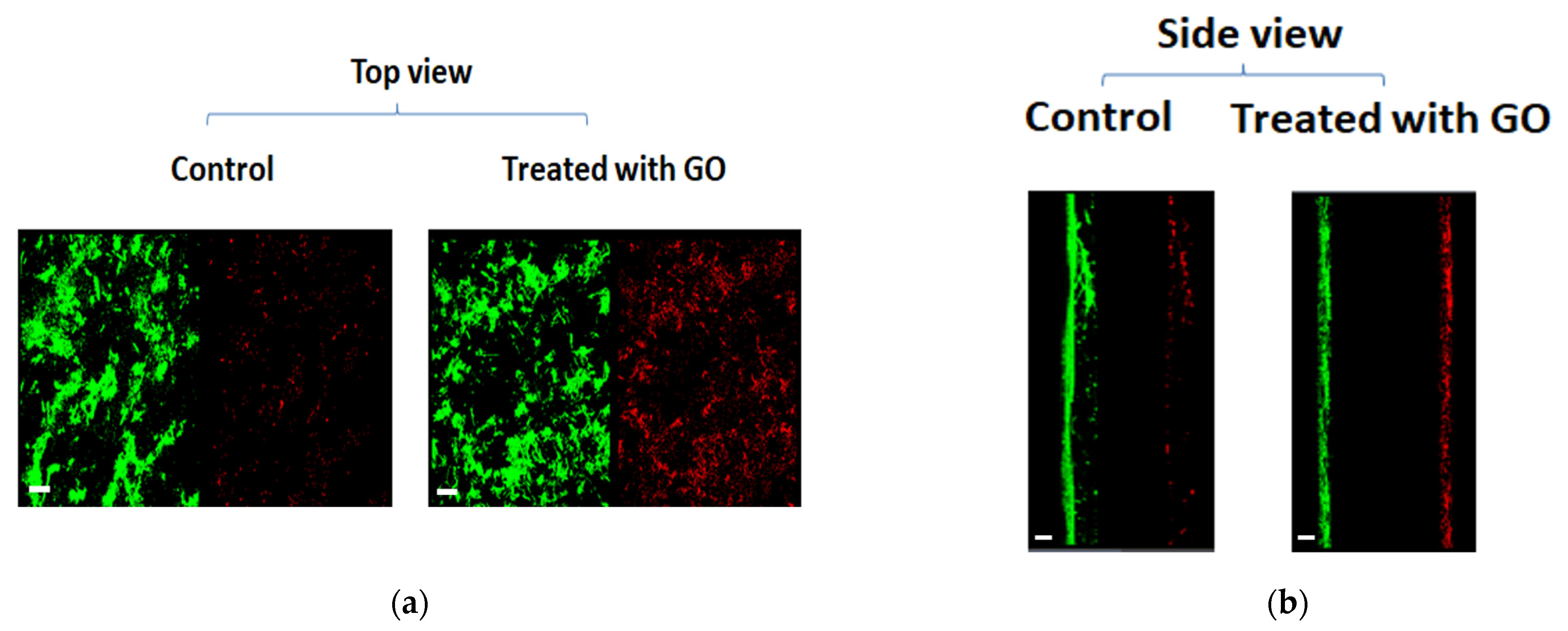
| pH | 5.0 | 6.0 | 7.0 |
|---|---|---|---|
| mL of sodium phosphate (0.2 M) | 25.7 | 33.1 | 43.6 |
| mL of citric acid (0.1 M) | 24.3 | 16.9 | 6.5 |
| deionized water (mL) | 50.0 | 50.0 | 49.9 |
| final volume (mL) | 100.0 | 100.0 | 100.0 |
| pH | 7.0 | 8.0 | 9.0 |
|---|---|---|---|
| mL of HCl (0.1 M) | 44.2 | 29.2 | 5.0 |
| deionized water (mL) | 155.8 | 170.8 | 195.0 |
| final volume (mL) | 200.0 | 200.0 | 200.0 |
| H2O | 5 | 6 | 7 | 7 | 8 | 9 | |
|---|---|---|---|---|---|---|---|
| (Pre-)-GO | 3.10 ± 0.15 | 2.60 ± 0.29 | 2.71 ± 1.02 | 3.35 ± 0.41 | 3.08 ± 79 | 3.22 ± 0.61 | 3.15 ± 0.35 |
| Cont-GO | 3.36 ± 0.12 | 2.82 ± 0.13 | 3.07 ± 0.57 | 3.19 ± 0.03 | 3.02 ± 0.28 | 3.21 ± 0.46 | 3.32 ± 0.17 |
| H2O | 51 mM | 219 mM | 320 mM | |
|---|---|---|---|---|
| (pre-)-GO | 2.64 ± 0.06 | 2.74 ± 0.13 | 3.52 ± 0.22 | 4.45 ± 0.71 |
| Cont-GO | 2.69 ± 0.27 | 2.98 ± 0.04 | 3.52 ± 0.01 | 4.45 ± 0.38 |
Disclaimer/Publisher’s Note: The statements, opinions and data contained in all publications are solely those of the individual author(s) and contributor(s) and not of MDPI and/or the editor(s). MDPI and/or the editor(s) disclaim responsibility for any injury to people or property resulting from any ideas, methods, instructions or products referred to in the content. |
© 2023 by the authors. Licensee MDPI, Basel, Switzerland. This article is an open access article distributed under the terms and conditions of the Creative Commons Attribution (CC BY) license (https://creativecommons.org/licenses/by/4.0/).
Share and Cite
Fallatah, H.; Overton, T.; Ali-Boucetta, H.; Gkatzionis, K. Impact of Environmental Stresses on the Antibacterial Activity of Graphene Oxide (GO) Nanoparticles against P. putida Biofilms. Microorganisms 2023, 11, 609. https://doi.org/10.3390/microorganisms11030609
Fallatah H, Overton T, Ali-Boucetta H, Gkatzionis K. Impact of Environmental Stresses on the Antibacterial Activity of Graphene Oxide (GO) Nanoparticles against P. putida Biofilms. Microorganisms. 2023; 11(3):609. https://doi.org/10.3390/microorganisms11030609
Chicago/Turabian StyleFallatah, Hussam, Tim Overton, Hanene Ali-Boucetta, and Konstantinos Gkatzionis. 2023. "Impact of Environmental Stresses on the Antibacterial Activity of Graphene Oxide (GO) Nanoparticles against P. putida Biofilms" Microorganisms 11, no. 3: 609. https://doi.org/10.3390/microorganisms11030609
APA StyleFallatah, H., Overton, T., Ali-Boucetta, H., & Gkatzionis, K. (2023). Impact of Environmental Stresses on the Antibacterial Activity of Graphene Oxide (GO) Nanoparticles against P. putida Biofilms. Microorganisms, 11(3), 609. https://doi.org/10.3390/microorganisms11030609








